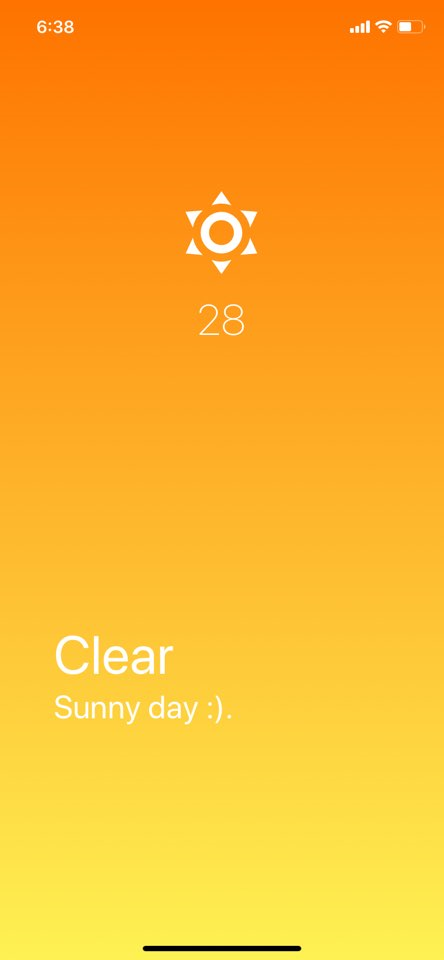Create Weather Screen
필요한 정보들은 모두 props로 전달받은 component를 구현하기만 하면 프로젝트는 완성이다.
함수형 component를 사용할 것이고 prop-types 모듈을 사용하여 편하게 props를 관리할 것이다.
다음은 Screen.js 코드이다.
import React from 'react';
import { StyleSheet, Text, View } from 'react-native';
import propTypes from 'prop-types';
import { LinearGradient } from 'expo-linear-gradient';
import { MaterialCommunityIcons } from '@expo/vector-icons';
const weatherOptions = {
Thunderstorm: {
iconName: "weather-lightning",
gradient: ["#373B44", "#4286f4"],
title: "Thunderstorm",
subtitle: "Watch out!!"
},
Drizzle: {
iconName: "weather-hail",
gradient: ["#89F7FE", "#66A6FF"],
title: "Drizzle",
subtitle: "Gray day..."
},
Rain: {
iconName: "weather-rainy",
gradient: ["#00C6FB", "#005BEA"],
title: "Rain",
subtitle: "Just don't go outside."
},
Snow: {
iconName: "weather-snowy",
gradient: ["#7DE2FC", "#B9B6E5"],
title: "Snow",
subtitle: "Let it go~."
},
Atmosphere: {
iconName: "weather-hail",
gradient: ["#89F7FE", "#66A6FF"],
title: "Atmosphere",
subtitle: "So So."
},
Clear: {
iconName: "weather-sunny",
gradient: ["#FF7300", "#FEF253"],
title: "Clear",
subtitle: "Sunny day :)."
},
Clouds: {
iconName: "",
gradient: ["#bdc3c7", "#2c3e50"],
title: "Clouds",
subtitle: "Don't laundry."
},
Mist: {
iconName: "weather-hail",
gradient: ["#616161", "#9bc5c3"],
title: "Mist",
subtitle: "I don't like Mist."
},
Dust: {
iconName: "weather-hail",
gradient: ["#BA8B02", "#181818"],
title: "Dust",
subtitle: "Must take a mask."
},
Haze: {
iconName: "weather-hail",
gradient: ["#4DA0B0", "#D39D38"],
title: "Haze",
subtitle: "Couldn't show front."
}
};
export default function Screen({temp,condition}){
return(
<LinearGradient // Background Linear Gradient
colors={weatherOptions.[condition].gradient}
style={styles.container}
>
<View style={styles.iconView}>
<MaterialCommunityIcons name={weatherOptions[condition].iconName} size={93} color="white" />
<Text style={{marginTop:10, fontSize: 40, fontWeight:"200",color:'white'}}>{temp}</Text>
</View>
<View style={styles.Text}>
<Text style={styles.title}>{weatherOptions[condition].title}</Text>
<Text style={styles.subtitle}>
{weatherOptions[condition].subtitle}
</Text>
</View>
</LinearGradient>
);
}
Screen.propTypes = {
temp: propTypes.number.isRequired,
condition: propTypes.oneOf(
["Thunderstorm",
"Drizzle",
"Rain",
"Snow",
"Atmosphere",
"Clear",
"Clouds",
"Haze",
"Mist",
"Dust"]).isRequired,
}
const styles = StyleSheet.create({
container: {
flex: 1,
alignItems: 'stretch',
justifyContent: 'center',
left: 0,
right: 0,
top: 0,
bottom: 0,
},
iconView: {
flex: 1,
alignItems: 'center',
justifyContent: 'center',
marginTop: 30,
},
Text: {
flex: 1,
alignItems: 'flex-start',
justifyContent: 'center',
},
title: {
fontSize: 50,
textAlign:'left',
marginLeft: 50,
color: 'white'
},
subtitle: {
fontSize: 30,
textAlign:'left',
marginLeft: 50,
marginBottom: 100,
color: 'white'
}
});
코드가 길지면 style과 conditionOption 때문에 그런 것 이기 때문에 겁먹지 않아도 된다.
크게 상단에 Icon과 온도를 render하는render 하는 View와 하단에 title과 subtitle을 render 하는 View로 나뉜다.
상단에는 center 정렬을 하고 싶었고, 하단에는 왼쪽에서 부터 쓰이기를 원했다.
( 이 부분은 자신의 입맛에 맞게 style을 변경해도 아무런 문제가 없다. )
원하는 style을 만들어 테스트용으로 <Text>를 이용하여 style이 맞게 적용됐나 확인했다.
문제없이 잘 만들어졌다.
이제는 props로 전달받은 데이터만 올바른 위치에 넣어 주기만 하면 된다.
Screen.propsTypes를 이용하여 props의 타입을 관리하였다.
weatherOption이라는 객체를 하나 정의해, 전달받은 props의 condition에 따라 원하는 값들을 다르게 적용시킬 수 있는 객체를 넣었다.
이제 Screen을 render할때 props를 참고하여 weatherOption에서 해당하는 값들을 읽어와 component를 render시킬
것이다.
다음은 출력 화면이다.

